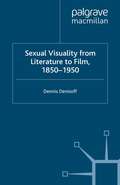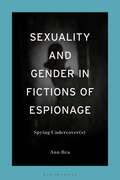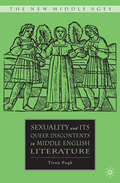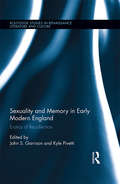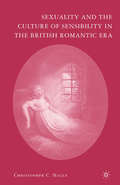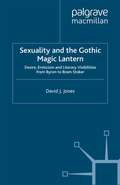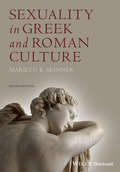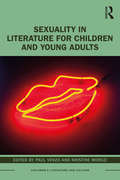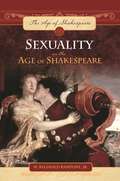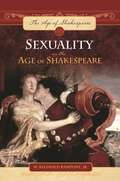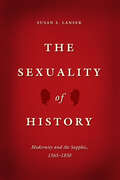- Table View
- List View
Sexual Teens, Sexual Media: Investigating Media's Influence on Adolescent Sexuality (Routledge Communication Series)
by Jane D. Brown Jeanne R. Steele Kim Walsh-ChildersThis collection explores the sexual content of U.S. mass media and its influence in the lives of adolescents. Contributors address the topic of sexuality broadly, including evidence not only about physical sex acts, but also about the role the media play in the development of gender roles, standards of beauty, courtship, and relationship norms. Chapters included here present new perspectives on what teens are paying attention to in the media, and offer insight into how teens are understanding and applying what the media present about sex and sexuality. Employing various methodological approaches, the studies also represent a diversity of adolescent audiences and deal with a wide variety of media content, ranging from teens' favorite TV programs to magazines, movies, music, and teen girls' Web pages. Taken as a whole, this volume highlights the significant roles the media play in adolescents' sexual lives. Sexual Teens, Sexual Media contributes important evidence to the ongoing debate over media effects, making it essential reading for scholars and students in media studies, as well as social and developmental psychology.
Sexual Violence in Western Thought and Writing: Chaste Rape
by V. VitanzaThis book focuses on rape narratives as grounding for western thinking about community - from the polis to nation-states - specifically in cultures of thinking , reading , and writing . The author rethinks rape, or sexual violence, through a close examination of how rape is a pedagogy that has become canonized in the form of rape stories.
Sexual Visuality From Literature To Film 1850-1950 (Palgrave Studies in Nineteenth-Century Writing and Culture)
by D. DenisoffA must-read for scholars of visuality, gender and sexuality. Denisoff's study explores the ways in which gothic, sensation and noir literature and cinema manipulated common notions of the visual in order to challenge sex- and gender-based assumptions that marginalized certain people and desires. Addressing authors and directors such as Mary Braddon, Wilkie Collins, Oscar Wilde, Vernon Lee, Virigina Woolf, Daphne du Maurier, Alfred Hitchcock, Otto Preminger and Fritz Lang, this study shows that what a society gets is often what it tries hardest not to see.
Sexuality and Gender in Fictions of Espionage: Spying Undercover(s)
by Ann ReaAn exploration of how espionage narratives give access to cultural conceptions of gender and sexuality before and following the Second World War, this book moves away from masculinist assumptions of the genre to offer an integrative survey of the sexualities on display from important characters across spy fiction. Topics covered include how authors mocked the traditional spy genre; James Bond as a symbol of pervasive British Superiority still anxious about masculinity; how older female spies act as queer figures that disturb the masculine mythology of the secret agent; and how the clandestine lives of agents described ways to encode queer communities under threat from fascism. Covering texts such as the Bond novels, John Le Carré's oeuvre (and their notable adaptations) and works by Helen MacInnes, Christopher Isherwood and Mick Herron, Sexuality and Gender in Fictions of Espionage takes stock of spy fiction written by women, female protagonists written by men, and probes the representations of masculinity generated by male authors. Offering a counterpoint to a genre traditionally viewed as male-centric, Sexuality and Gender in Fictions of Espionage proposes a revision of masculinity, femininity, queer identities and gendered concepts such as domesticity, and relates them to notions of nationality and the defence work conducted at crucial moments in history.
Sexuality and Gender in Fictions of Espionage: Spying Undercover(s)
An exploration of how espionage narratives give access to cultural conceptions of gender and sexuality before and following the Second World War, this book moves away from masculinist assumptions of the genre to offer an integrative survey of the sexualities on display from important characters across spy fiction. Topics covered include how authors mocked the traditional spy genre; James Bond as a symbol of pervasive British Superiority still anxious about masculinity; how older female spies act as queer figures that disturb the masculine mythology of the secret agent; and how the clandestine lives of agents described ways to encode queer communities under threat from fascism. Covering texts such as the Bond novels, John Le Carré's oeuvre (and their notable adaptations) and works by Helen MacInnes, Christopher Isherwood and Mick Herron, Sexuality and Gender in Fictions of Espionage takes stock of spy fiction written by women, female protagonists written by men, and probes the representations of masculinity generated by male authors. Offering a counterpoint to a genre traditionally viewed as male-centric, Sexuality and Gender in Fictions of Espionage proposes a revision of masculinity, femininity, queer identities and gendered concepts such as domesticity, and relates them to notions of nationality and the defence work conducted at crucial moments in history.
Sexuality and Gender in the English Renaissance: An Annotated Edition of Contemporary Documents (Garland Studies in the Renaissance #Vol. 10)
by Lloyd DavisFirst published in 1998. This anthology coomprises a diverse range of historical treatises and tracts that discuss and debate gender and sexual relations in early modern England. Combining complete texts and extracts-many hitherto unavailable in modern editions-the collection focuses on prevailing conceptions of sexuality and gender in major areas and institutions of Tudor and Stuart society. A broad selection of religious sermons, moral handbooks, household manuals, midwifery and legal textbooks, ballads and chapbooks has been chosen.
Sexuality and Gender in the English Renaissance: An Annotated Edition of Contemporary Documents (Garland Studies in the Renaissance)
by Lloyd DavisFirst published in 1998. This anthology coomprises a diverse range of historical treatises and tracts that discuss and debate gender and sexual relations in early modern England. Combining complete texts and extracts-many hitherto unavailable in modern editions-the collection focuses on prevailing conceptions of sexuality and gender in major areas and institutions of Tudor and Stuart society. A broad selection of religious sermons, moral handbooks, household manuals, midwifery and legal textbooks, ballads and chapbooks has been chosen.
Sexuality and its Queer Discontents in Middle English Literature (The New Middle Ages)
by T. PughThis book exposes the ways in which ostensibly normative sexualities depend upon queerness to shore up their claims of privilege. Through readings of such classic texts as The Canterbury Tales and Eger and Grime , Tison Pugh explains how sexual normativity can often be claimed only after queerness has been rejected.
Sexuality and Memory in Early Modern England: Literature and the Erotics of Recollection (Routledge Studies in Renaissance Literature and Culture)
by John S. Garrison Kyle PivettiThis volume brings together two vibrant areas of Renaissance studies today: memory and sexuality. The contributors show that not only Shakespeare but also a broad range of his contemporaries were deeply interested in how memory and sexuality interact. Are erotic experiences heightened or deflated by the presence of memory? Can a sexual act be commemorative? Can an act of memory be eroticized? How do forms of romantic desire underwrite forms of memory? To answer such questions, these authors examine drama, poetry, and prose from both major authors and lesser-studied figures in the canon of Renaissance literature. Alongside a number of insightful readings, they show that sonnets enact a sexual exchange of memory; that epics of nationhood cannot help but eroticize their subjects; that the act of sex in Renaissance tragedy too often depends upon violence of the past. Memory, these scholars propose, re-shapes the concerns of queer and sexuality studies – including the unhistorical, the experience of desire, and the limits of the body. So too does the erotic revise the dominant trends of memory studies, from the rhetoric of the medieval memory arts to the formation of collective pasts.
Sexuality and Memory in Early Modern England: Literature and the Erotics of Recollection (Routledge Studies in Renaissance Literature and Culture)
by John S. Garrison Kyle PivettiThis volume brings together two vibrant areas of Renaissance studies today: memory and sexuality. The contributors show that not only Shakespeare but also a broad range of his contemporaries were deeply interested in how memory and sexuality interact. Are erotic experiences heightened or deflated by the presence of memory? Can a sexual act be commemorative? Can an act of memory be eroticized? How do forms of romantic desire underwrite forms of memory? To answer such questions, these authors examine drama, poetry, and prose from both major authors and lesser-studied figures in the canon of Renaissance literature. Alongside a number of insightful readings, they show that sonnets enact a sexual exchange of memory; that epics of nationhood cannot help but eroticize their subjects; that the act of sex in Renaissance tragedy too often depends upon violence of the past. Memory, these scholars propose, re-shapes the concerns of queer and sexuality studies – including the unhistorical, the experience of desire, and the limits of the body. So too does the erotic revise the dominant trends of memory studies, from the rhetoric of the medieval memory arts to the formation of collective pasts.
Sexuality and the Culture of Sensibility in the British Romantic Era
by C. NagleThis is the first study to fully trace the influence of Sensibility on British Romanticism. Sensibility continually found new forms of expression in the late Eighteenth and early Nineteenth century. Nagle explores how it coexisted and intermingled with Romanticism and revises the traditional narratives of literary periodization of this era.
Sexuality and the Erotic in the Fiction of Joseph Conrad (Continuum Literary Studies)
by Jeremy HawthornAwarded third place for The Adam Gillon Book Award in Conrad Studies 2009 The book presents a sustained critique of the interlinked (and contradictory) views that the fiction of Joseph Conrad is largely innocent of any interest in or concern with sexuality and the erotic, and that when Conrad does attempt to depict sexual desire or erotic excitement then this results in bad writing. Jeremy Hawthorn argues for a revision of the view that Conrad lacks understanding of and interest in sexuality. He argues that the comprehensiveness of Conrad's vision does not exclude a concern with the sexual and the erotic, and that this concern is not with the sexual and the erotic as separate spheres of human life, but as elements dialectically related to those matters public and political that have always been recognized as central to Conrad's fictional achievement. The book will open Conrad's fiction to readings enriched by the insights of critics and theorists associated with Gender Studies and Post-colonialism.
Sexuality and the Erotic in the Fiction of Joseph Conrad (Continuum Literary Studies)
by Jeremy HawthornAwarded third place for The Adam Gillon Book Award in Conrad Studies 2009 The book presents a sustained critique of the interlinked (and contradictory) views that the fiction of Joseph Conrad is largely innocent of any interest in or concern with sexuality and the erotic, and that when Conrad does attempt to depict sexual desire or erotic excitement then this results in bad writing. Jeremy Hawthorn argues for a revision of the view that Conrad lacks understanding of and interest in sexuality. He argues that the comprehensiveness of Conrad's vision does not exclude a concern with the sexual and the erotic, and that this concern is not with the sexual and the erotic as separate spheres of human life, but as elements dialectically related to those matters public and political that have always been recognized as central to Conrad's fictional achievement. The book will open Conrad's fiction to readings enriched by the insights of critics and theorists associated with Gender Studies and Post-colonialism.
Sexuality and the Gothic Magic Lantern: Desire, Eroticism and Literary Visibilities from Byron to Bram Stoker (Palgrave Gothic)
by D. JonesThis fascinating study explores the multifarious erotic themes associated with the magic lantern shows, which proved the dominant visual medium of the West for 350 years, and analyses how the shows influenced the portrayals of sexuality in major works of Gothic fiction.
Sexuality, Gender and Nationalism in Caribbean Literature (Routledge Research in Postcolonial Literatures)
by Kate HouldenThis book focuses on sex and sexuality in post-war novels from the Anglophone Caribbean. Countering the critical orthodoxy that literature from this period dealt with sex only tangentially, implicitly transmitting sexist or homophobic messages, the author instead highlights the range and diversity in its representations of sexual life. She draws on gender and sexuality studies, postcolonial theory and cultural history to provide new readings of seminal figures like Samuel Selvon and George Lamming whilst also calling attention to the work of innovative, lesser-studied authors such as Andrew Salkey, Oscar Dathorne and Rosa Guy. Offering a coherent and expansive overview of how post-war Caribbean novelists have treated the persistently controversial topic of sex, this book addresses one of the blind spots in Caribbean literary criticism. It mines a range of little-studied archival materials and texts to argue that fiction of the post-war era exhibits both continuities with the sexual emphases of earlier writing and connections to later trends. The author also presents nationalist ideology as central to the literature of this era. It is in the fictional rendering of sexuality that the contradictions of the nationalist project are most apparent; sex both exceeds and threatens the imagined unity on which the political vision depends.
Sexuality, Gender and Nationalism in Caribbean Literature (Routledge Research in Postcolonial Literatures)
by Kate HouldenThis book focuses on sex and sexuality in post-war novels from the Anglophone Caribbean. Countering the critical orthodoxy that literature from this period dealt with sex only tangentially, implicitly transmitting sexist or homophobic messages, the author instead highlights the range and diversity in its representations of sexual life. She draws on gender and sexuality studies, postcolonial theory and cultural history to provide new readings of seminal figures like Samuel Selvon and George Lamming whilst also calling attention to the work of innovative, lesser-studied authors such as Andrew Salkey, Oscar Dathorne and Rosa Guy. Offering a coherent and expansive overview of how post-war Caribbean novelists have treated the persistently controversial topic of sex, this book addresses one of the blind spots in Caribbean literary criticism. It mines a range of little-studied archival materials and texts to argue that fiction of the post-war era exhibits both continuities with the sexual emphases of earlier writing and connections to later trends. The author also presents nationalist ideology as central to the literature of this era. It is in the fictional rendering of sexuality that the contradictions of the nationalist project are most apparent; sex both exceeds and threatens the imagined unity on which the political vision depends.
Sexuality, Iconography, and Fiction in French
by Jason James HartfordThis book explores the modern cultural history of the queer martyr in France and Belgium. By analyzing how popular writers in French responded to Catholic doctrine and the tradition of St. Sebastian in art, Queering the Martyr shows how religious and secular symbols overlapped to produce not one, but two martyr-types. These are the queer type, typified first by Gustave Flaubert, which is a philosophical foil, and the gay type, popularized by Jean Genet but created by the Belgian Georges Eekhoud, which is a political and pornographic device. Grounded in feminist queer theory and working from a post-psychoanalytical point of view, the argument explores the potential and limits of these two figures, noting especially the persistence of misogyny in religious culture.
Sexuality in Greek and Roman Culture (Ancient Cultures #3)
by Marilyn B. SkinnerThis agenda-setting text has been fully revised in its second edition, with coverage extended into the Christian era. It remains the most comprehensive and engaging introduction to the sexual cultures of ancient Greece and Rome. Covers a wide range of subjects, including Greek pederasty and the symposium, ancient prostitution, representations of women in Greece and Rome, and the public regulation of sexual behavior Expanded coverage extends to the advent of Christianity, includes added illustrations, and offers student-friendly pedagogical features Text boxes supply intriguing information about tangential topics Gives a thorough overview of current literature while encouraging further reading and discussion Conveys the complexity of ancient attitudes towards sexuality and gender and the modern debates they have engendered
Sexuality in Greek and Roman Culture (Ancient Cultures)
by Marilyn B. SkinnerThis agenda-setting text has been fully revised in its second edition, with coverage extended into the Christian era. It remains the most comprehensive and engaging introduction to the sexual cultures of ancient Greece and Rome. Covers a wide range of subjects, including Greek pederasty and the symposium, ancient prostitution, representations of women in Greece and Rome, and the public regulation of sexual behavior Expanded coverage extends to the advent of Christianity, includes added illustrations, and offers student-friendly pedagogical features Text boxes supply intriguing information about tangential topics Gives a thorough overview of current literature while encouraging further reading and discussion Conveys the complexity of ancient attitudes towards sexuality and gender and the modern debates they have engendered
Sexuality in Literature for Children and Young Adults (Children's Literature and Culture)
by Paul VenzoExpanding outward from previous scholarship on gender, queerness, and heteronormativity in children’s literature, this book offers fresh insights into representations of sex and sexuality in texts for young people. In this collection, new and established scholars examine how fiction and non-fiction writing, picture books, film and television and graphic novels position young people in relation to ideologies around sexuality, sexual identity, and embodiment. This book questions how such texts communicate a sense of what is possible, impossible, taboo, or encouraged in terms of being sexual and sexual being. Each chapter is motivated by a set of important questions: How are representations of sex and sexuality depicted in texts for young people? How do these representations affect and shape the kinds of sexualities offered as models to young readers? And to what extent is sexual diversity acknowledged and represented across different narrative and aesthetic modes? This work brings together a diverse range of conceptual and theoretical approaches that are framed by the idea of sexual becoming: the manner in which texts for young people invite their readers to assess and potentially adopt ways of thinking and being in terms of sex and sexuality.
Sexuality in Literature for Children and Young Adults (Children's Literature and Culture)
by Paul Venzo Kristine MoruziExpanding outward from previous scholarship on gender, queerness, and heteronormativity in children’s literature, this book offers fresh insights into representations of sex and sexuality in texts for young people. In this collection, new and established scholars examine how fiction and non-fiction writing, picture books, film and television and graphic novels position young people in relation to ideologies around sexuality, sexual identity, and embodiment. This book questions how such texts communicate a sense of what is possible, impossible, taboo, or encouraged in terms of being sexual and sexual being. Each chapter is motivated by a set of important questions: How are representations of sex and sexuality depicted in texts for young people? How do these representations affect and shape the kinds of sexualities offered as models to young readers? And to what extent is sexual diversity acknowledged and represented across different narrative and aesthetic modes? This work brings together a diverse range of conceptual and theoretical approaches that are framed by the idea of sexual becoming: the manner in which texts for young people invite their readers to assess and potentially adopt ways of thinking and being in terms of sex and sexuality.
Sexuality in the Age of Shakespeare (The Age of Shakespeare)
by W. Reginald Jr.This book examines the important themes of sexuality, gender, love, and marriage in stage, literary, and film treatments of Shakespeare's plays.The theme of sexuality is often integral to Shakespeare's works and therefore merits a thorough exploration.Sexuality in the Age of Shakespeare begins with descriptions of sexuality in ancient Greece and Rome, medieval England, and early-modern Europe and England, then segues into examinations of the role of sexuality in Shakespeare's plays and poetry, and also in film and stage productions of his plays. The author employs various theoretical approaches to establish detailed interpretations of Shakespeare's plays and provides excerpts from several early-modern marriage manuals to illustrate the typical gender roles of the time. The book concludes with bibliographies that students of Shakespeare will find invaluable for further study.
Sexuality in the Age of Shakespeare (The Age of Shakespeare)
by W. Reginald Jr.This book examines the important themes of sexuality, gender, love, and marriage in stage, literary, and film treatments of Shakespeare's plays.The theme of sexuality is often integral to Shakespeare's works and therefore merits a thorough exploration.Sexuality in the Age of Shakespeare begins with descriptions of sexuality in ancient Greece and Rome, medieval England, and early-modern Europe and England, then segues into examinations of the role of sexuality in Shakespeare's plays and poetry, and also in film and stage productions of his plays. The author employs various theoretical approaches to establish detailed interpretations of Shakespeare's plays and provides excerpts from several early-modern marriage manuals to illustrate the typical gender roles of the time. The book concludes with bibliographies that students of Shakespeare will find invaluable for further study.
Sexuality, Obscenity and Community: Women, Muslims, and the Hindu Public in Colonial India (Comparative Feminist Studies)
by C. GuptaThrough analysis of an impressive array of 'low' and 'high' Hindu literatures, particularly pamphlets, tracts, newspapers, and archival data, Gupta explores the emerging discourse of gender and sexuality, which was essential to the development of notions of Hindu communitality and nationalism in the colonial period. The book offers an exceptionally nuanced account of Hindi gender politics.
The Sexuality of History: Modernity and the Sapphic, 1565-1830
by Susan S. LanserThe period of reform, revolution, and reaction that characterized seventeenth- and eighteenth-century Europe also witnessed an intensified interest in lesbians. In scientific treatises and orientalist travelogues, in French court gossip and Dutch court records, in passionate verse, in the rising novel, and in cross-dressed flirtations on the English and Spanish stage, poets, playwrights, philosophers, and physicians were placing sapphic relations before the public eye. In The Sexuality of History, Susan S. Lanser shows how intimacies between women became harbingers of the modern, bringing the sapphic into the mainstream of some of the most significant events in Western Europe. Ideas about female same-sex relations became a focal point for intellectual and cultural contests between authority and liberty, power and difference, desire and duty, mobility and change, order and governance. Lanser explores the ways in which a historically specific interest in lesbians intersected with, and stimulated, systemic concerns that would seem to have little to do with sexuality. Departing from the prevailing trend of queer reading whereby scholars ferret out hidden content in “closeted” texts, Lanser situates overtly erotic representations within wider spheres of interest. The Sexuality of History shows that just as we can understand sexuality by studying the past, so too can we understand the past by studying sexuality.


